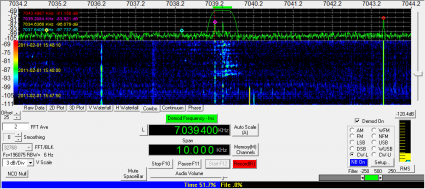Single Letter Beacons, with some QRM
I like using my SDR-IQ software defined receiver for listening to short wave and ham bands. It’s a great way to look at a bunch of frequencies all at once, and to isolate the signals you are interested in. I had heard that there were new versions of the SDR-Radio application and Spectravue which I hadn’t tried out yet, so last night and this morning I tried them both out.
I’ll defer SDR-Radio to a later time (I think I screwed up something in the configuration, and my tired brain couldn’t figure it out), but Spectravue has a nice new AGC control that really works well. In any case, that’s what I used for this morning’s mucking around.
Here is what the main screen looks like. You can see that I’m scanning a segment of spectrum 10khz wide, centered on 7.0392Mhz. That corresponds to the frequency of the Russian “F” beacon. You can see the trace of its signal in the waterfall down the display. Just to the right of it you can see another dashed line. That’s at about 7.0394Mhz, and is the Russian “M” beacon. And you can see a bit of blobbiness all around them: that’s a voice signal which is overlapping them. I can’t make out what they are saying or doing. But here’s my recording anyway.
It’s a .wav file, but only 8khz sampling and 60 seconds long.
I decoded this with a typical CW filter with 500hz, which isn’t wide enough to decode the signal, but it isn’t strong enough to really work out. Perhaps some more knowledgeable types could tell me who operates voice down this low.
Addendum: A few minutes later, the voices were much stronger. Spanish speaking, it would appear. Here’s a bit of it, recorded with a more appropriate filter setting of 2.7khz LSB:
Spanish voices, on 7.040Mhz LSB
Addendum2: Upon listening to it some more, I’m actually not 100% sure it is Spanish.

I recall burning three or four weeks of a sabbatical getting Saccade.com on the air with Wordpress. So much tweaking…